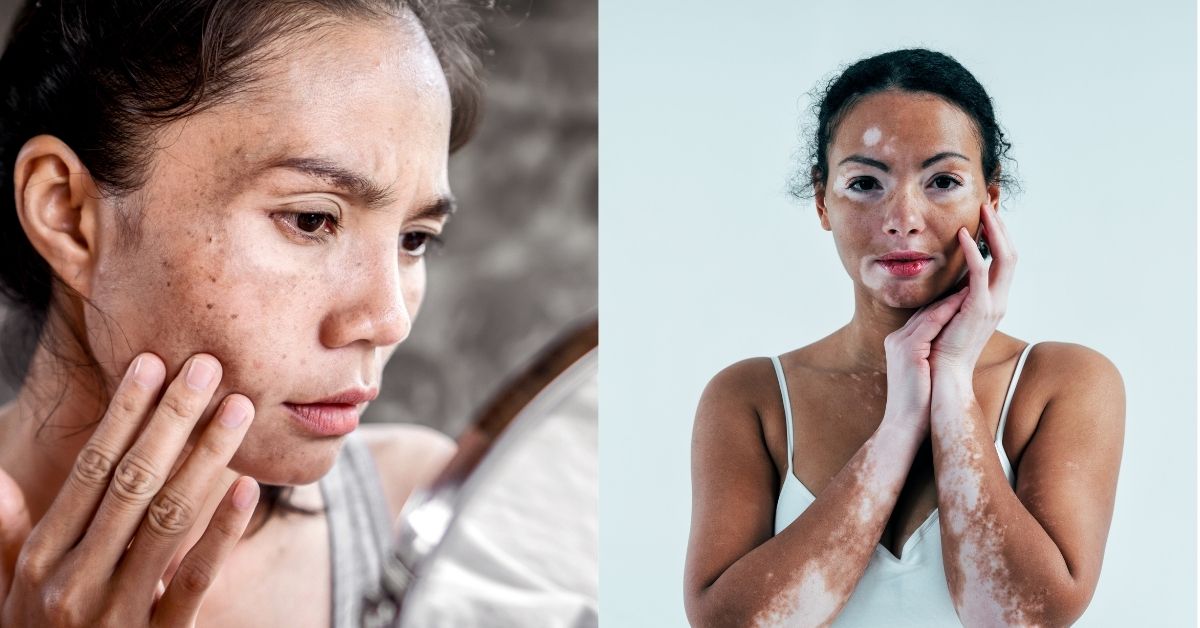
-
Posted By drruby.Sachdev@gmail.com
-
-
Comments 0
Skin pigmentation disorders can cause significant distress and confusion. Among the most common conditions are hypopigmentation and vitiligo, both of which result in changes to skin color. While they share some similarities, they are distinct conditions with different causes, symptoms, and treatments. This comprehensive guide will delve into the key differences between hypopigmentation and vitiligo, their causes, symptoms, and how to manage them.
Understanding Hypopigmentation
Definition
Hypopigmentation refers to patches of skin that become lighter than the surrounding areas. This occurs due to a reduction in melanin, the pigment responsible for skin color. Hypopigmentation of skin can result from various factors, leading to lighter, non vitiligo white spots or hypopigmented patches.
Causes
The causes of hypopigmentation vary widely and can include:
- Skin injuries: Burns, blisters, and other skin trauma can damage melanocytes, the cells that produce melanin.
- Inflammatory skin conditions: Diseases like eczema, psoriasis, and dermatitis can cause hypopigmentation.
- Infections: Fungal infections such as tinea versicolor can lead to hypopigmented patches.
- Genetic conditions: Conditions like albinism and piebaldism are inherited disorders affecting melanin production.
Types of Hypopigmentation
- Post-inflammatory hypopigmentation: Occurs after an inflammatory skin condition heals.
- Idiopathic guttate hypomelanosis: Small, white spots that commonly appear on the shins and forearms of older adults.
- Pityriasis alba: A common skin condition in children causing hypopigmented patches, often after sun exposure.
Symptoms
- Lighter skin patches: The primary symptom is areas of skin that are lighter than the surrounding skin.
- Texture changes: These patches may sometimes have a different texture compared to normal skin.
- No discomfort: Typically, hypopigmentation does not cause pain or itching.
Diagnosis
Diagnosing hypopigmentation involves:
- Physical examination: A dermatologist examines the skin under a Wood’s lamp to highlight areas of pigmentation loss.
- Medical history: Reviewing the patient’s medical history to identify potential causes.
- Skin biopsy: In some cases, a skin biopsy might be necessary to confirm the diagnosis.
Treatment Options
Treatment for hypopigmentation depends on the underlying cause:
- Topical treatments: Steroids, retinoids, and calcineurin inhibitors can help restore pigmentation.
- Phototherapy: Exposure to specific wavelengths of light can stimulate melanin production.
- Camouflage techniques: Makeup and self-tanning products can temporarily even out skin tone.
- Addressing underlying conditions: Treating the root cause, such as an infection or inflammatory condition, is crucial.
Understanding Vitiligo
Definition
Vitiligo is an autoimmune disorder characterized by the loss of melanocytes, leading to white patches on the skin. Unlike general hypopigmentation of skin, vitiligo causes more pronounced, often symmetrical depigmented areas.
Causes
Vitiligo is primarily caused by:
- Autoimmune response: The body’s immune system mistakenly attacks and destroys melanocytes.
- Genetic factors: A family history of vitiligo or other autoimmune diseases increases the risk.
- Environmental triggers: Stress, skin trauma, or exposure to certain chemicals may trigger or worsen vitiligo.
Symptoms
- White patches: The most noticeable symptom is white patches on the skin, often on the face, hands, and feet.
- Symmetry: Patches are often symmetrical and can expand over time.
- Affects hair and eyes: Vitiligo can also affect hair color and the pigmentation of the eyes.
Diagnosis
Diagnosing vitiligo involves:
- Physical examination: A dermatologist examines the skin, often using a Wood’s lamp.
- Medical history: Assessing family history and any autoimmune conditions.
- Blood tests: To check for associated autoimmune disorders.
- Skin biopsy: Rarely, a biopsy may be performed to differentiate vitiligo from other conditions.
Treatment Options
Treatment for vitiligo aims to restore color or even out skin tone:
- Topical treatments: Corticosteroids and calcineurin inhibitors can help repigment the skin.
- Phototherapy: Narrowband UVB light therapy is a common treatment.
- Depigmentation: In severe cases, depigmenting the remaining skin to match the white patches may be an option.
- Surgical options: Skin grafts and melanocyte transplants are available for stable vitiligo.
Comparing Hypopigmentation and Vitiligo
Key Differences
- Cause:
- Hypopigmentation: Often results from skin injury, inflammation, or infections.
- Vitiligo: An autoimmune disorder with a genetic component.
- Appearance:
- Hypopigmentation: Lighter patches that may vary in size and shape.
- Vitiligo: Distinct white patches, often symmetrical and expanding over time.
- Treatment:
- Hypopigmentation: Focuses on treating the underlying cause.
- Vitiligo: Focuses on repigmentation and managing the autoimmune response.
Key Similarities
- Pigmentation loss: Both conditions result in areas of the skin that are lighter than the surrounding areas.
- Non-contagious: Neither condition is infectious or contagious.
- Psychological impact: Both can affect self-esteem and quality of life, highlighting the importance of psychological support.
Living with Hypopigmentation and Vitiligo
Psychological Impact
Living with hypopigmentation or vitiligo can be challenging:
- Self-esteem: Changes in appearance can affect confidence and self-image.
- Social interactions: Some individuals may feel self-conscious in social situations.
- Emotional well-being: It’s essential to address feelings of anxiety or depression with professional support.
Support and Resources
- Support groups: Connecting with others who have similar conditions can provide emotional support.
- Educational resources: Learning about the conditions helps manage them effectively.
- Professional help: Dermatologists, counselors, and therapists can offer comprehensive care.
Conclusion
Understanding the differences between hypopigmentation and vitiligo is crucial for effective management. Both conditions lead to changes in skin color but have distinct causes, symptoms, and treatments. By addressing the underlying causes and seeking appropriate treatments, individuals can manage these conditions and maintain a good quality of life. If you notice changes in your skin pigmentation, consult a dermatologist for an accurate diagnosis and personalized treatment plan.
Frequently Asked Questions
A dermatologist can diagnose the condition through physical examination, medical history, and possibly a skin biopsy. Hypopigmentation often results from external factors like injuries or infections, while vitiligo is an autoimmune disorder with symmetrical white patches.
Primarily, both conditions affect skin color. However, vitiligo can also affect hair color and the pigmentation of the eyes. Neither typically causes pain or physical discomfort, but they can have significant psychological impacts.
Vitiligo has a genetic component, and a family history of vitiligo or other autoimmune diseases increases the risk. Hypopigmentation can be caused by genetic conditions like albinism but is often related to external factors.
Understanding and addressing these skin conditions involves a combination of medical treatment and psychological support. Whether dealing with hypopigmented patches or non vitiligo white spots, it’s essential to seek professional advice to manage the condition effectively.
Recent Posts
- Bangalore Monsoon Skin SOS: Dr Ruby Sachdev’s Tips to Beat Seasonal Breakouts
- Stretch Marks Demystified: Only These Treatments Really Fade Them—Here’s Why
- Dry Scalp vs. Dandruff? Spot the Difference & End the Itch for Good
- 🧴 Pollution + UV in Bangalore? Why Sunscreen Alone Isn’t Enough—Your Complete Daily Skin Defense
- Glass Skin Treatment in Bangalore: Is It Worth the Hype?




